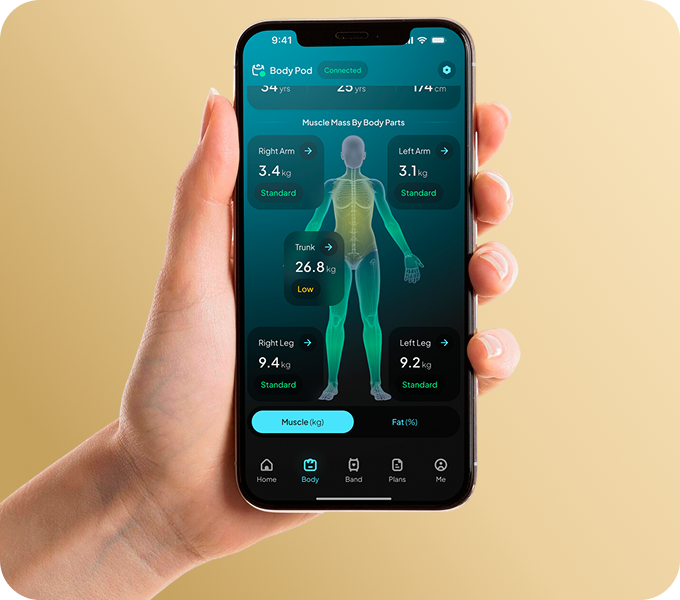Cardiovascular Metrics

Resting Heart Rate
- Definition: Heart rate measured during deep sleep periods, representing cardiovascular efficiency
- Low (Good): Indicates excellent cardiovascular fitness and autonomic nervous system health
- High (Concerning): May indicate poor cardiovascular fitness, stress, overtraining, or underlying health issues
- Improvement: Consistent aerobic exercise, stress management, adequate sleep, weight management
Heart Rate Variability (HRV)
- Definition: Variation in time between heartbeats during deep sleep, measuring autonomic nervous system health
- Low: Poor autonomic balance, high stress, overtraining, or cardiovascular dysfunction
- High: Excellent recovery capacity, good stress resilience, optimal autonomic function
- Improvement: Regular exercise, meditation, breathing exercises, consistent sleep schedule, stress reduction
Heart Rate Consistency
- Definition: Variance between minimum and maximum heart rates during sleep and wake periods
- Low: Good cardiovascular stability and autonomic regulation
- High: Poor cardiovascular stability, potential arrhythmias, or autonomic dysfunction
- Improvement: Regular cardio exercise, consistent sleep patterns, stress management, avoiding stimulants
Baseline SpO2
- Definition: Typical oxygen saturation during normal active periods (excluding sleep/exercise)
- Low: Potential respiratory issues, cardiovascular problems, or altitude effects
- High: Excellent oxygen transport and lung function
- Improvement: Cardiovascular exercise, breathing exercises, altitude training, smoking cessation
SpO2 Consistency
- Definition: Stability of oxygen saturation levels during wake periods
- Low: Unstable oxygen transport, potential respiratory or cardiovascular issues
- High: Stable respiratory and cardiovascular function
- Improvement: Consistent exercise, respiratory training, environmental air quality optimization
Cardiovascular Health Score
- Definition: Composite 0-100 score combining all cardiovascular metrics with weighted importance
- Low: Multiple cardiovascular risk factors present
- High: Excellent overall cardiovascular health across all measured parameters
- Improvement: Address individual component metrics based on specific deficiencies
Sleep Architecture Metrics

Total Sleep Duration
- Definition: Complete time spent in all sleep stages during main sleep period
- Low: Sleep debt accumulation, impaired recovery, cognitive dysfunction
- High: Optimal recovery, good sleep hygiene (unless excessive indicating underlying issues)
- Improvement: Consistent bedtime routine, sleep environment optimization, stress management
Deep Sleep Percentage
- Definition: Percentage of total sleep spent in slow-wave sleep stages
- Low: Poor physical recovery, impaired tissue repair, reduced growth hormone release
- High: Excellent physical recovery and tissue regeneration
- Improvement: Regular exercise, cool sleep environment, consistent schedule, avoid alcohol/caffeine
REM Sleep Percentage
- Definition: Percentage of total sleep spent in rapid eye movement sleep
- Low: Poor cognitive recovery, memory consolidation issues, mood regulation problems
- High: Excellent cognitive recovery and memory processing
- Improvement: Stress reduction, regular sleep schedule, avoid sleep medications, manage anxiety
Light Sleep Percentage
- Definition: Percentage of total sleep spent in lighter sleep stages
- Low: May indicate sleep efficiency issues or measurement problems
- High: Excessive light sleep may indicate poor sleep quality or external disturbances
- Improvement: Sleep environment optimization, stress reduction, consistent routine
Awake Percentage
- Definition: Percentage of sleep period spent awake
- Low: Good sleep continuity and efficiency
- High: Sleep fragmentation, potential sleep disorders, environmental disturbances
- Improvement: Sleep environment optimization, stress management, evaluate potential sleep disorders
Sleep Quality Score
- Definition: Composite score evaluating sleep architecture, continuity, and physical indicators
- Low: Multiple sleep quality issues affecting recovery
- High: Excellent sleep quality supporting optimal recovery
- Improvement: Address specific sleep architecture deficiencies and sleep hygiene factors
Sleep Debt
- Definition: Accumulated deficit in quality-adjusted sleep hours
- Low: Well-rested with adequate sleep recovery
- High: Significant sleep deficit affecting performance and health
- Improvement: Earlier bedtime, sleep schedule consistency, sleep quality optimization
Activity & Strain Metrics

Daily Steps
- Definition: Total steps taken throughout the day
- Low: Sedentary lifestyle, increased health risks
- High: Active lifestyle supporting cardiovascular and metabolic health
- Improvement: Gradual step increase, walking meetings, take stairs, parking farther
Active Minutes
- Definition: Time spent in elevated heart rate zones (Zone 2+)
- Low: Insufficient cardiovascular stimulation
- High: Good cardiovascular training stimulus
- Improvement: Structured exercise, active commuting, recreational activities
Zone 2 Minutes
- Definition: Time spent at 60-70% maximum heart rate (moderate intensity)
- Low: Poor aerobic base development
- High: Excellent aerobic fitness foundation
- Improvement: Brisk walking, easy jogging, cycling, swimming at conversational pace
Zone 3 Minutes
- Definition: Time spent at 70-80% maximum heart rate (vigorous intensity)
- Low: Limited lactate threshold development
- High: Good cardiovascular efficiency training
- Improvement: Tempo runs, cycling intervals, sustained vigorous exercise
Zone 4 Minutes
- Definition: Time spent at 80-90% maximum heart rate (high intensity)
- Low: Limited VO2max development
- High: Excellent high-intensity cardiovascular training
- Improvement: HIIT training, sprint intervals, high-intensity sports
Active Calories
- Definition: Energy expenditure from physical activity above resting metabolic rate
- Low: Sedentary lifestyle, low energy expenditure
- High: Active lifestyle with significant energy expenditure
- Improvement: Increase exercise frequency/intensity, add resistance training
Strain Score
- Definition: Quantified physical and mental stress relative to daily capacity
- Low: Insufficient training stimulus for adaptation
- High: Optimal training load or potential overreaching
- Improvement: Balance training load with recovery, progressive overload principles
Recovery Metrics

Recovery Score
- Definition: Effectiveness of recovery activities in addressing accumulated strain
- Low: Insufficient recovery relative to strain, fatigue accumulation
- High: Excellent recovery matching or exceeding strain demands
- Improvement: Prioritize sleep, active recovery, stress management, nutrition optimization
Strain Recovery Ratio
- Definition: Proportion of strain effectively addressed by recovery activities
- Low: Recovery deficit leading to accumulated fatigue
- High: Recovery surplus supporting adaptation and performance
- Improvement: Increase recovery activities, improve sleep quality, manage stress
Metabolic Metrics

Metabolic Capacity
- Definition: Daily capacity for physical and mental stress. Sort of like a personal battery gauge. (1-100 scale)
- Low: Reduced tolerance for physical/mental demands
- High: Excellent capacity for handling daily stressors and training
- Improvement: Improve health score components, optimize sleep, manage stress
Metabolic Momentum
- Definition: Direction and velocity of metabolic health changes (-20 to +20 scale)
- Low/Negative: Declining health trajectory (getting less healthy with age. At very low scores, -10 or lower, represents aging faster than you should)
- High/Positive: Improving metabolic health trajectory (Getting more healthy, aging slower. At very high Metabolic Momentum, +12 or higher, aging in reverse)
- Improvement: Address unrecovered strain, improve recovery quality, optimize lifestyle factors
Base Metabolic Capacity
- Definition: Typical maximum strain tolerance derived from Health Score
- Low: Reduced physiological resilience and recovery potential
- High: Excellent physiological resilience and recovery capacity
- Improvement: Long-term health optimization across all measured parameters













